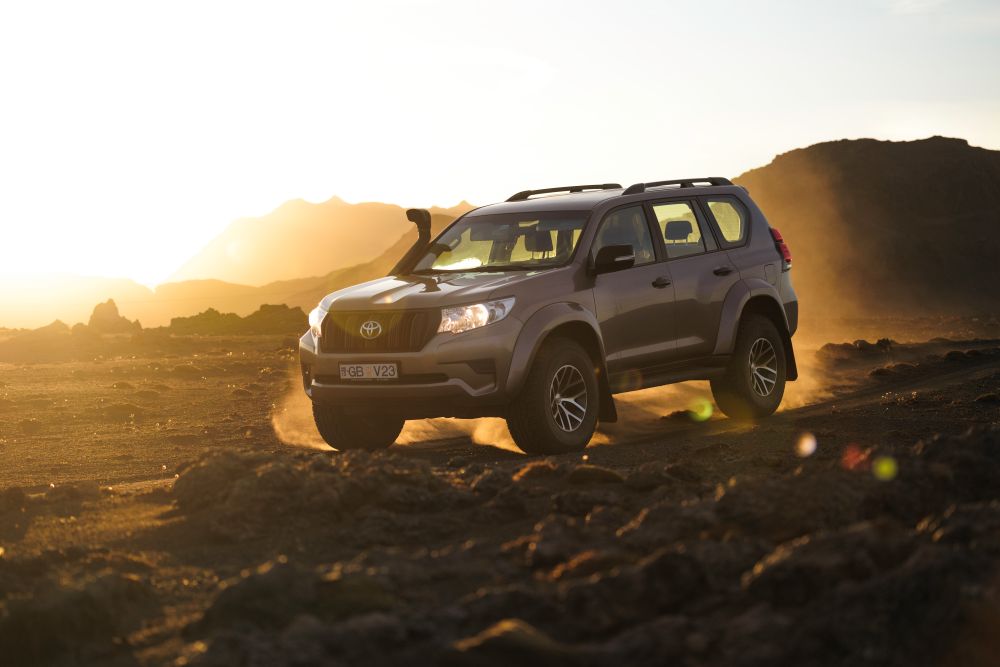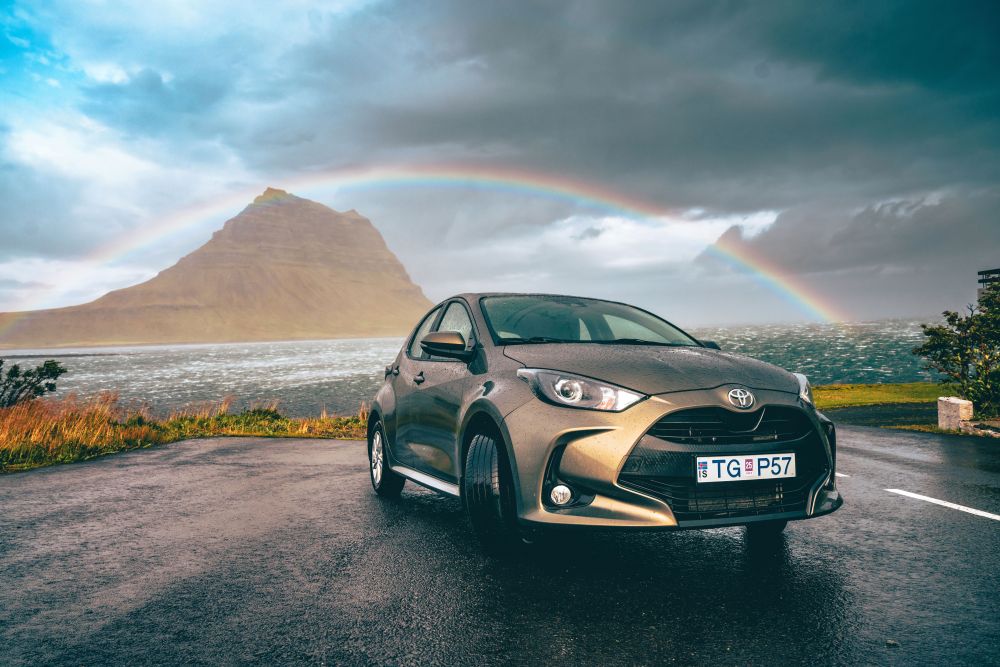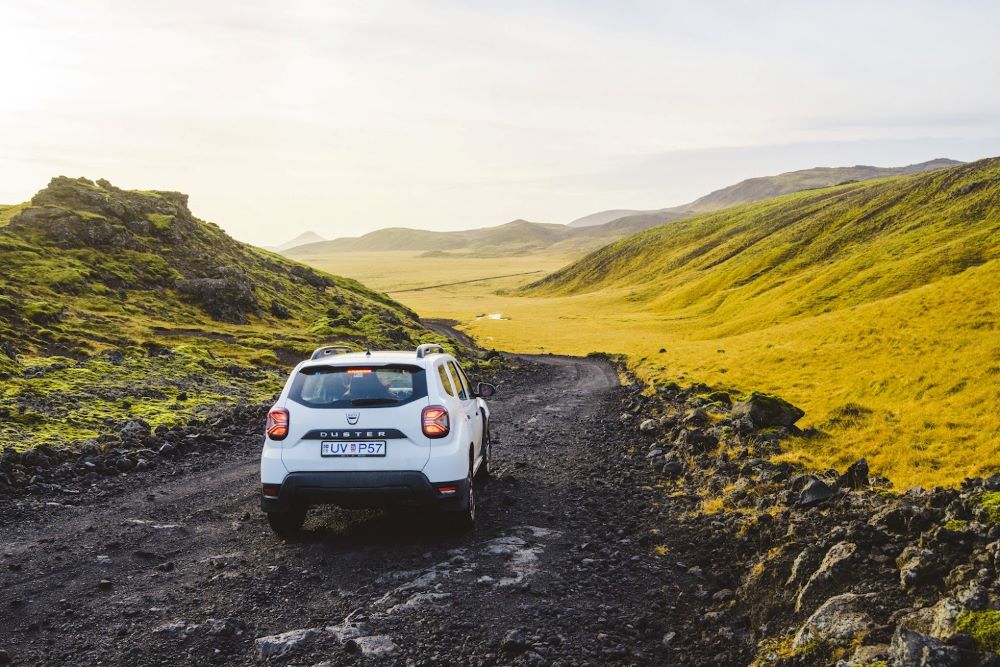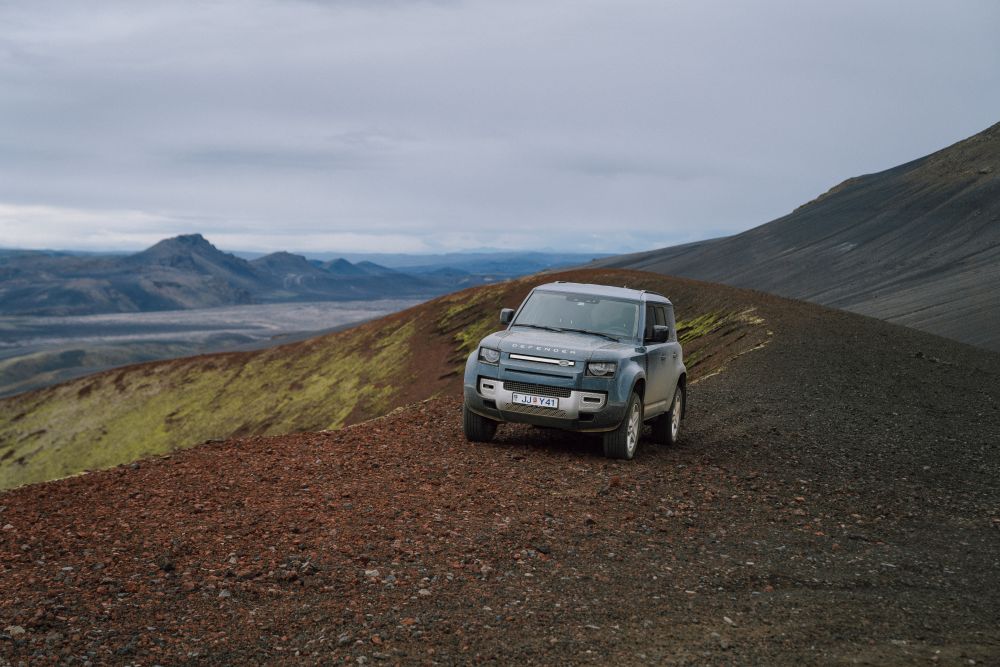
Renting a car for an Iceland trip often leads to one big question: 4x4 or not 4x4? With Iceland’s rugged terrain and unpredictable weather, many travelers wonder if they must rent a four-wheel-drive vehicle, or if a regular 2WD car will do. Rather than a one-size-fits-all answer, it depends on your specific plans.
Before you book your rental car in Iceland ask yourself these 7 questions to make the right choice for your trip:
1. When are you traveling (summer or winter)?
The time of year hugely impacts road conditions. If you’re visiting in winter (roughly late October through April), a 4x4 is strongly recommended. Snow, ice, and slush on roads are common in winter, even on the main highways. A 4x4 (with proper winter tires) provides better traction and stability in slippery conditions. Icelandic winters can be harsh with blizzards and sudden snowfalls. So, having a four-wheel drive can be a lifesaver for keeping you moving safely. Here’s a helpful winter driving guide for more insights.
In summer, however, most primary roads are clear and dry. From May to September, a 2WD car can handle Ring Road and all paved or well-graded gravel roads easily. So if your trip is in July and you’re sticking to typical tourist routes, you don’t need a 4x4. Check out this summer road trip guide for inspiration.
If you're traveling during shoulder season, spring offers a unique experience with mixed conditions. Here’s one of the best spring road trip routes to explore by rental car.
In short, think of it this way: winter = 4x4 highly advised; summer = 4x4 optional (depending on where you go, see next points).
2. Where do you plan to drive?
Look at the places you want to visit. Your itinerary is the biggest factor for which rental car is best suited for your trip.
- Sticking to the main Ring Road (Route 1) and popular sites like the Golden Circle, South Coast (Seljalandsfoss, Jökulsárlón), Snæfellsnes peninsula, etc.? These routes are mostly paved or well-maintained gravel. A 2WD vehicle can comfortably reach all major attractions in Iceland during summer and even shoulder seasons. In good weather, you won’t have issues.
- Planning to venture into the Highlands or F-Roads? If names like Landmannalaugar, Þórsmörk, Askja, or Kerlingarfjöll are on your list, these require driving on F-roads – mountain roads marked with an “F” that are only open in summer and legally require a 4x4. These roads have rough gravel, potholes, streams or rivers to cross, and no services. A regular car is not allowed and would not survive these trails. You’ll need a 4x4, preferably a sturdy one with high clearance (a Jeep, Land Rover, Toyota Hilux, etc.). Some F-roads have deep river crossings – even with a 4x4, crossing is risky (rental insurance typically doesn’t cover water damage, keep that in mind). When in doubt, leave the extreme highland roads to the experts.
- Visiting in-between areas? For example, the Westfjords or certain backroads in East Iceland aren’t F-roads but can be very rough or steep. A 4x4 can be beneficial for those too, offering comfort on washboard gravel and better handling on steep mountain roads (like the ones leading to Borgarfjörður Eystri or Seyðisfjörður). If your plans include remote towns or off-the-beaten-path spots, consider a 4x4 for peace of mind.
In summary, map out your must-see spots. If all of them lie along paved roads, a 2WD is fine. The more you stray into wilderness, the more you’ll want a 4x4.

3. What are your driving conditions likely to be?
Beyond season and location, think about road conditions you’re comfortable with. Even in summer, Iceland has gravel roads (for example, parts of the road to Dettifoss waterfall, or the Eastfjords coastal routes). Driving long stretches of gravel in a tiny 2WD can be slow and nerve-wracking (loose gravel = less traction, risk of stone chips). A 4x4 SUV often has better suspension and tires for gravel, making that experience smoother. Also, consider weather anomalies: a summer trip can still have heavy rain or the occasional summer snowfall at higher elevations.
A 4x4 typically handles mud or slick conditions better than a sedan. Are you planning on camping or sleeping in the car? Larger 4x4 vehicles (or camper 4x4s) offer more space and capability to get to secluded campsites. On the flip side, if you’re only driving between hotels on the main roads, a smaller car is easier to park and uses less fuel. It boils down to this: expecting any “off-pavement” adventures or unpredictable roads = lean 4x4; only smooth sailing on known routes = 2WD suffices.
4. How many people are in your group (and how much luggage)?
Oddly, this practical consideration matters. A larger group or family with lots of luggage might find an economy car too cramped for a week-long road trip. 4x4 SUVs are generally roomier, with more trunk space for bags and gear. If you’re four people with full-size suitcases, a small 2WD hatchback will require some Tetris skills and likely blocking rear visibility with bags. A larger 4x4 (like a Toyota RAV4 or Land Cruiser) can fit everyone and their stuff comfortably. Even if roads are easy, comfort on a long drive (the Ring Road is 1332 km/828 miles) is important. Conversely, if you’re a solo traveler or couple traveling light, you might not need the extra space of a 4x4 and could be perfectly content (and get better gas mileage) with a compact car. Keep in mind child seats: if you need one or two car seats for kids, an SUV will give your little ones more breathing room.
Blue Car Rental offers a range of vehicle sizes. So, pick one that fits your group first. From there, decide if you want the added capability of 4x4 based on other factors.

5. What’s your comfort level with driving?
Think about your own driving experience and confidence. If you’re accustomed to driving only small cars or you feel nervous driving in unfamiliar conditions, that could influence your choice:
- Some travelers feel more secure in a robust 4x4, knowing they have a vehicle built for tough roads. The higher seating position gives a commanding view of the road, which can be reassuring.
- Others might feel more comfortable in a smaller car that handles like what they’re used to at home. A big SUV can be intimidating if you’ve never driven one, and it does require more caution around tight city streets or parking.
- Automatics vs manual: Many 4x4 rentals in Iceland are automatic, which can be easier for those not used to manual transmission (manual is common in Europe). If you only drive auto, ensure you book accordingly (Blue Car Rental has both options, but automatics, especially 4x4 automatics, get booked early).
- If you’re not a confident driver in adverse conditions (like high winds or icy roads), having a 4x4 won’t replace careful driving, but it can provide better control. Traction control, AWD/4WD, and heavier weight all contribute to stability. However, you still must adjust your driving to conditions. Keep in mind that a 4x4 helps you go, but it doesn’t make you invincible.
In short, know thyself. If a 4x4 will ease your mind and you’re okay handling a larger vehicle, it could enhance your trip confidence. If you’d stress about driving a big SUV, stick to a smaller car and plan a route within its limits.
6. What’s your budget?
Cost is a practical factor. 4x4 vehicles do cost more to rent than economy cars. You might be looking at, for example, $80–$120 USD per day for a compact car vs. $150–$250 USD per day for a 4x4 or SUV (rates vary by season and car model). Also, 4x4s typically consume more fuel, and fuel in Iceland is expensive. So beyond the rental rate, consider gas costs (a Jeep or large SUV will get fewer miles per gallon than a small sedan). If you’re on a tight budget, and your itinerary doesn’t demand a 4x4, you can save a lot by renting a fuel-efficient 2WD. Many travelers successfully circle all of Iceland in a little Toyota Yaris or similar in summer and use the savings for other experiences. Visiting in the cheapest season can also help stretch your travel budget further.
However, don’t let cost be the only deciding factor if safety or access is at stake: needing a 4x4 and not having one could ruin parts of your trip (you don’t want to risk getting stuck or unable to reach a dream location). One compromise is to adjust your itinerary to your vehicle. If you choose 2WD to save money, plan routes that avoid F-roads and risky conditions. Alternatively, if you splurge on a 4x4, maximize its use by seeing some off-beat places!
Blue Car Rental has a reward program with discount offers and additionally, often has seasonal deals or early booking discounts that can narrow the price gap, so check for coupon code promotions.

7. Are there alternatives for certain legs of your trip?
Maybe you’re now leaning toward a 2WD but worried about one part of your plan, or vice versa. Remember, you can mix modes:
- Take a Super Jeep tour for a specific highland area instead of taking your own car. For example, if you really want to see Landmannalaugar or drive on a glacier, there are tour operators with modified 4x4 vehicles that can take you while you leave your 2WD at the hotel for the day. This way you don’t need a 4x4 for the entire trip.
- Domestic flights or buses: To reach some far places without driving the whole way on tough roads, consider flying (e.g., fly to Egilsstaðir in East Iceland and rent a car from there, skipping some long drives). The Icelandic bus network is limited, but there are Highland buses in summer that go to places like Þórsmörk you could ride in, hike, and ride out.
- Car swap: In some cases, travelers rent a 2WD for part of the trip and then switch to a 4x4 for a few days when needed (or vice versa). While a bit of a hassle, it can be cost-effective. For instance, rent a compact car while touring the South Coast and West, then return it and rent a 4x4 just for your 4-day highland adventure portion.
These ideas are just to show that you have options. If only one segment of your vacation needs a 4x4, you might not need to pay for it the whole time. However, if your answer to most of the above questions leans toward rough roads, winter weather, offbeat places, etc., then it’s simpler (and usually more enjoyable) to just rent the 4x4 from the start and have the freedom throughout.
Conclusion
If you tallied up your answers and found many “Yes, I’m going in winter or to remote areas, and I value safety/comfort,” then go for the 4x4. You’ll appreciate the capability and likely have access to every spot on your wish list. If instead you’re doing a classic summer trip, hitting the famous spots on well-traveled roads, a 2WD will serve you well, you can allocate the cost savings to hotels or excursions (or a nice hot spring soak!).
Still undecided? Feel free to contact Blue Car Rental with your itinerary, our team will honestly advise if a 4x4 is needed or if a cheaper 2WD would suffice. We have one of the largest selections of vehicles in Iceland, from tiny city cars to rugged Super Jeeps, so we’ll make sure you get the perfect match. And before you book, make sure to understand the ins and outs of car rental insurance in Iceland. It’s key to traveling with peace of mind.
No matter what you choose, drive carefully and enjoy the ride. In Iceland, the journey is just as wonderful as the destination — whether you conquer it in a big 4x4 or a little runabout. Happy driving!




